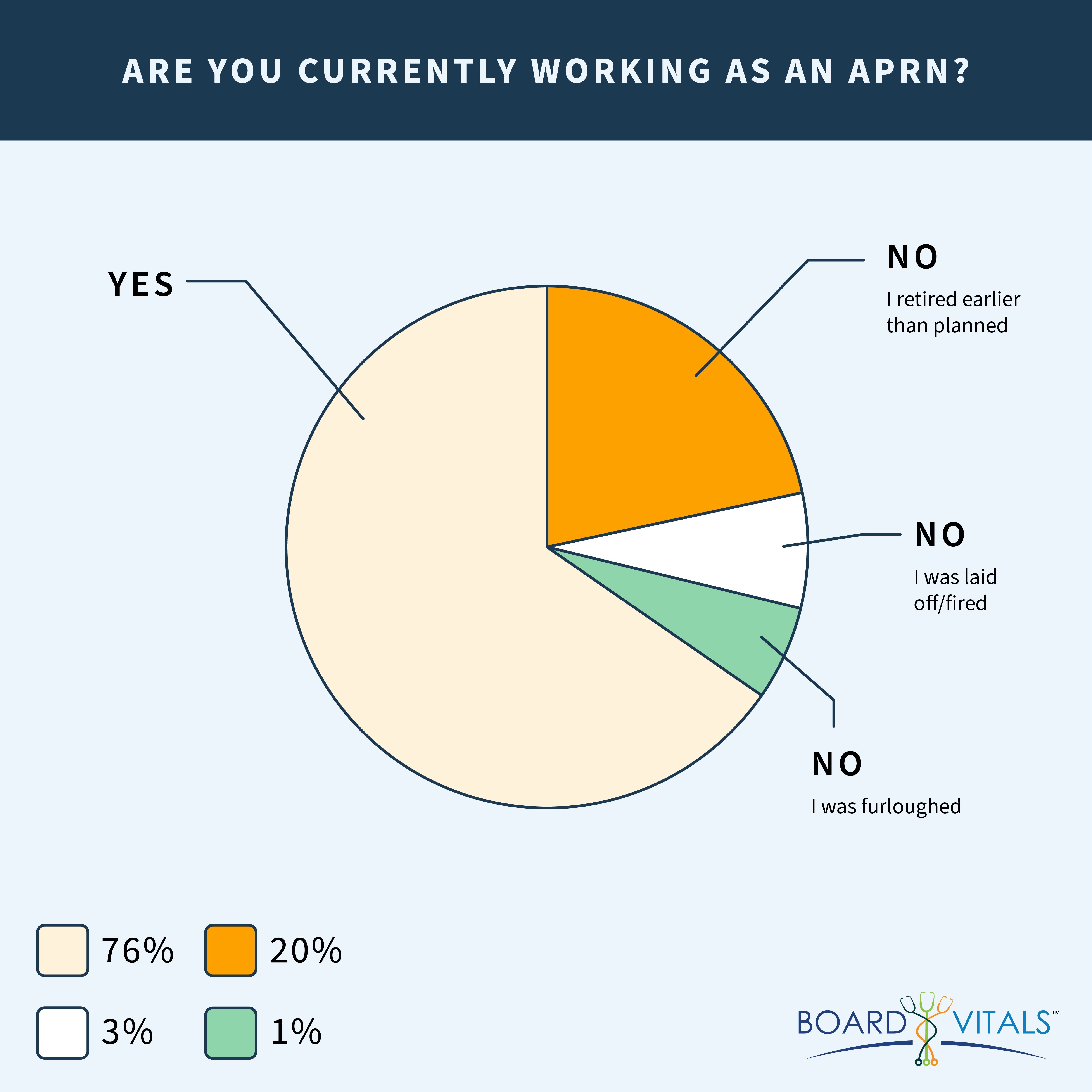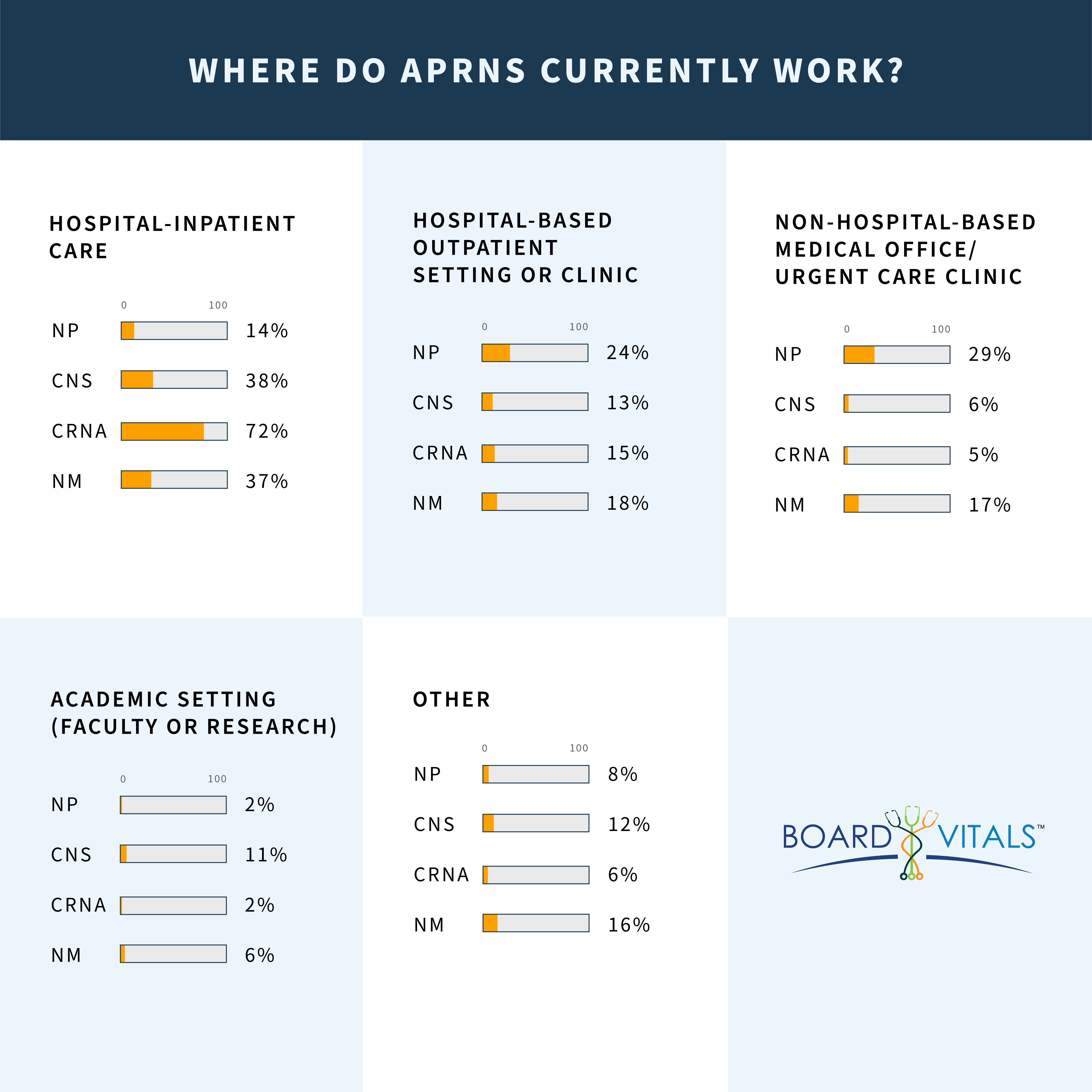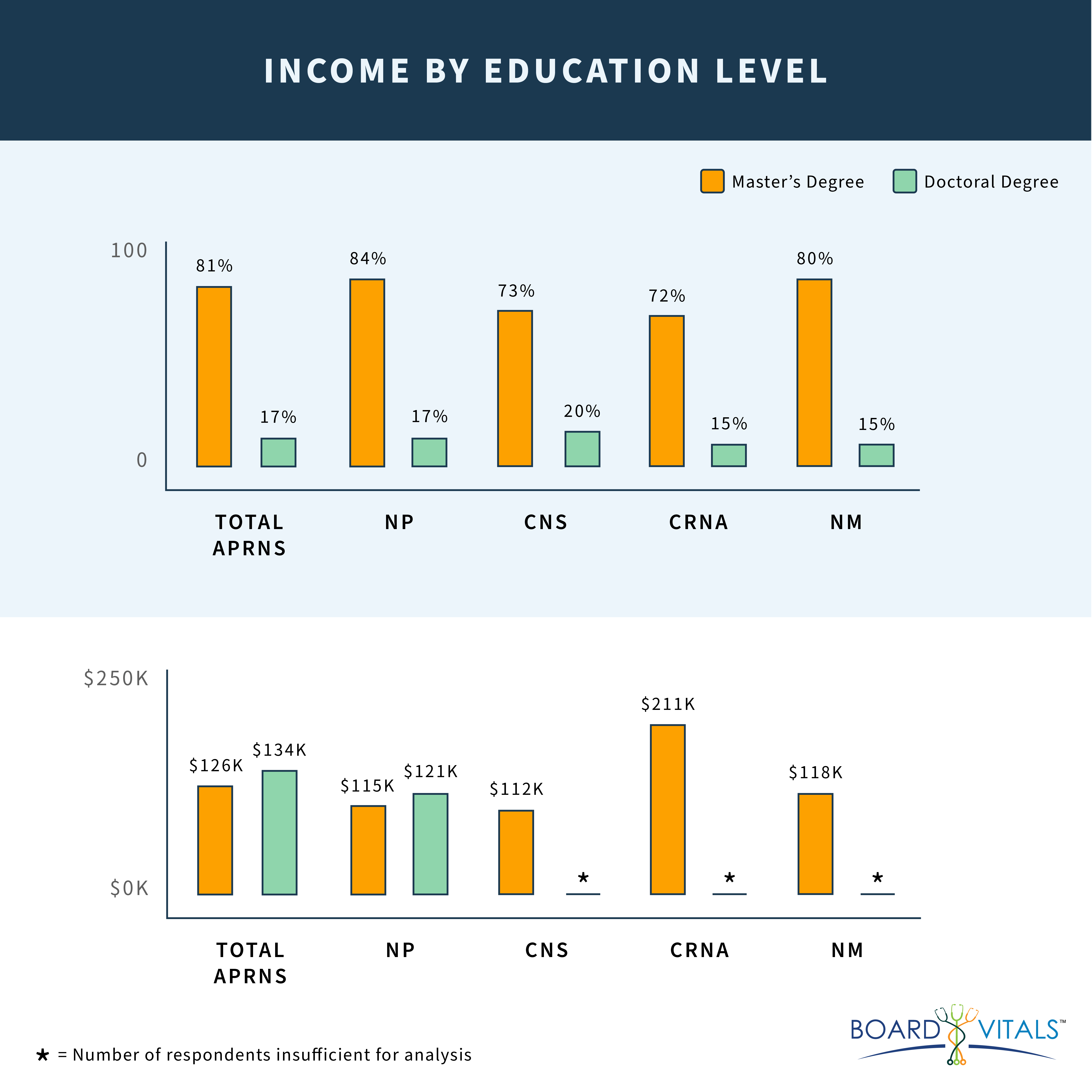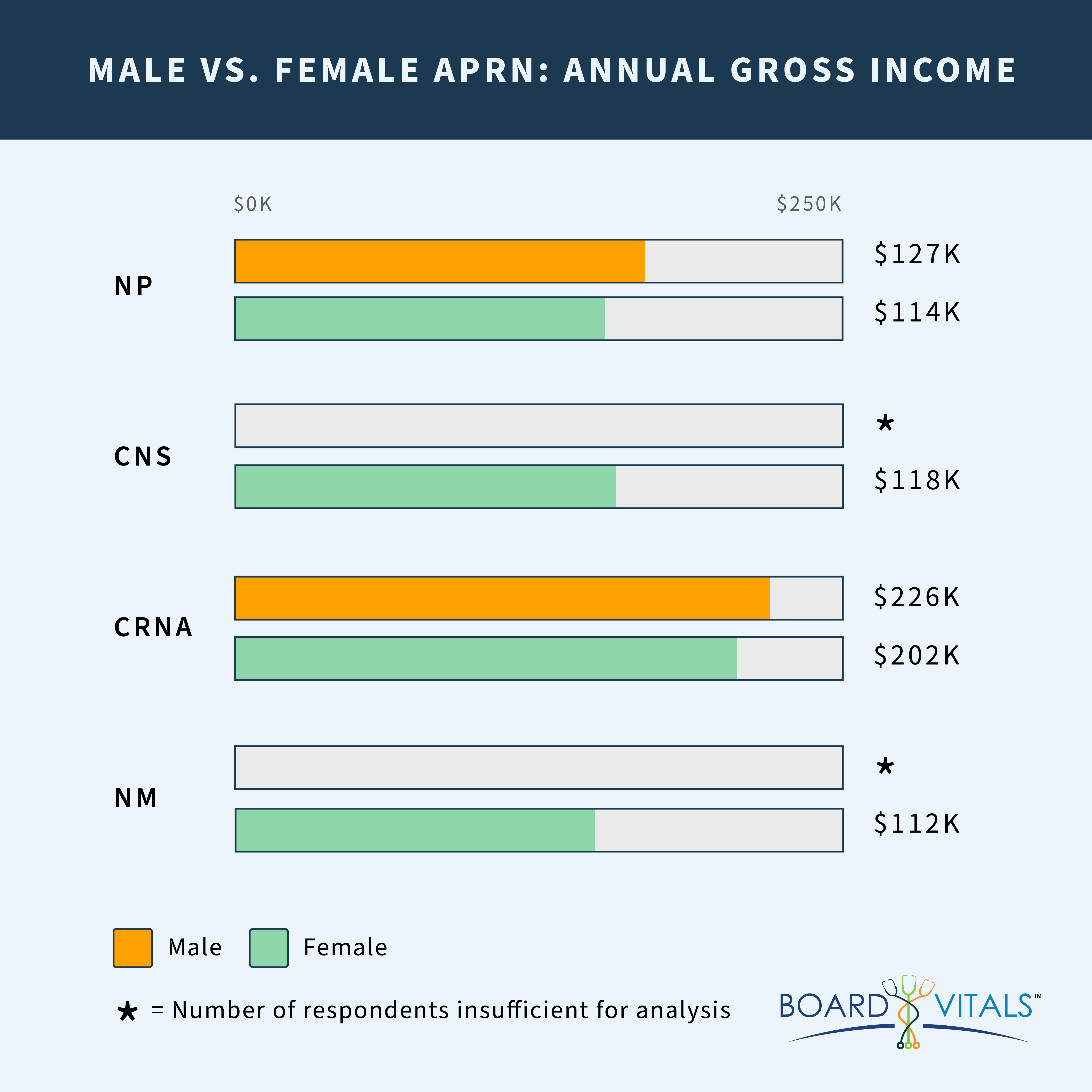For the past seven years, Medscape has surveyed Advanced Practice Registered Nurses (APRNs) regarding job details, including salary and job satisfaction. The 2021 survey measured many of the effects of COVID, including salary changes, furloughed positions, and APRNs switching careers altogether.
The following post summarizes the 2021 report and highlights possible changes in the job of an APRN due to the pandemic.
Medscape APRN Compensation Report
Medscape surveyed 3309 APRNs: 380 certified registered nurse anesthetists (CRNAs), 2016 nurse practitioners (NPs), 505 clinical nurse specialists (CNSs), and 408 nurse midwives (NMs).
Employment Status and the Pandemic
 About 24 percent of survey takers said they were not currently employed as APRNs and did not qualify to continue the survey. About one in four of those surveyors stated the pandemic as the reason for unemployment and twenty percent stated they retired earlier than planned. Overall, however, when surveyed regarding pre-pandemic work conditions, there was very little shifting in the work settings of APRNs.
About 24 percent of survey takers said they were not currently employed as APRNs and did not qualify to continue the survey. About one in four of those surveyors stated the pandemic as the reason for unemployment and twenty percent stated they retired earlier than planned. Overall, however, when surveyed regarding pre-pandemic work conditions, there was very little shifting in the work settings of APRNs.
Finally, among the remaining APRNs who stated they were not working, but had not retired, four percent surveyed as furloughed, laid off, or fired. However, some recent reports state that most APRNs have returned to pre-pandemic positions.
Where do APRNs work?
 As seen in the 2020 report, APRN employment area did not have major changes. 37% of NMs versus 34% from the 2020 report stated they were employed in a hospital setting. Otherwise, 29 percent of NPs reported to work in a non-hospital-based outpatient setting, followed by 24 percent who reported to work in a hospital-based outpatient setting. The majority of CRNAs (72 percent) reported to work in an inpatient setting. Likewise, the majority of NMs (37 percent) and CNSs (38 percent) all work in inpatient settings.
As seen in the 2020 report, APRN employment area did not have major changes. 37% of NMs versus 34% from the 2020 report stated they were employed in a hospital setting. Otherwise, 29 percent of NPs reported to work in a non-hospital-based outpatient setting, followed by 24 percent who reported to work in a hospital-based outpatient setting. The majority of CRNAs (72 percent) reported to work in an inpatient setting. Likewise, the majority of NMs (37 percent) and CNSs (38 percent) all work in inpatient settings.
APRN Compensation
 Gross income reported by APRNs appeared to increase slightly from 2019 to 2020. However median incomes this year were actually lower than the incomes reported in the survey. The income was not adjusted for inflation or cost of living, but the average was as follows: NPs (114.5K), CNS (109.5k), CRNA (206.5K), and NM (116.5K).
Gross income reported by APRNs appeared to increase slightly from 2019 to 2020. However median incomes this year were actually lower than the incomes reported in the survey. The income was not adjusted for inflation or cost of living, but the average was as follows: NPs (114.5K), CNS (109.5k), CRNA (206.5K), and NM (116.5K).
NPs who work in inpatient settings reported the highest annual income of 125K based on 2020 earnings. Psychiatric/Mental Health NPs were the highest-earning certification at 128K per year, followed by Adult Gerontology Acute Care NPs at 116K.
Full Time vs Part-Time
 Over the years, the Medscape survey has indicated a declining number of APRNs working full-time. As of the 2021 report, 73 to 85 percent of APRNs work full-time depending on their specialty. The declining number working full-time cannot be firmly explained, but it is considered that perhaps there is a significant number nearing retirement.
Over the years, the Medscape survey has indicated a declining number of APRNs working full-time. As of the 2021 report, 73 to 85 percent of APRNs work full-time depending on their specialty. The declining number working full-time cannot be firmly explained, but it is considered that perhaps there is a significant number nearing retirement.
It was also determined that hourly versus salaried APRNs may be at an advantage for a higher income.
Practice Ownership
Very few APRNs own their own practice and growth has not increased over the past year with the exception of CNs, whose practice ownership grew from 6 to 7%. APRNs who own their own practices earn an average of 158K annually as opposed to 126K annual income for APRNs who did not own their practice.
Clinical Practice Arrangement
Despite the fact that over half of the states do not require a collaborating agreement with a physician, a majority of APRNs reported they work in such an arrangement.
Income by Education Level
 Most APRNs hold a Master’s degree (81 percent), but roughly 17 percent now hold a doctoral degree (DNP or PhD). APRNs who reported to hold doctoral degrees, earn a 5% higher salary than those with Master’s degrees.
Most APRNs hold a Master’s degree (81 percent), but roughly 17 percent now hold a doctoral degree (DNP or PhD). APRNs who reported to hold doctoral degrees, earn a 5% higher salary than those with Master’s degrees.
Salary for Male vs. Female APRNs
 Males represent 37 percent of CRNAs, but much fewer CNSs (7%), NPs (9%), and NMs (1%). Of the data that could be analyzed, male NPs reported an eight percent higher salary than females and male CRNAs reported fifteen percent higher salary than females. This has increased from the previous year, suggesting the gap is not closing, but actually widening.
Males represent 37 percent of CRNAs, but much fewer CNSs (7%), NPs (9%), and NMs (1%). Of the data that could be analyzed, male NPs reported an eight percent higher salary than females and male CRNAs reported fifteen percent higher salary than females. This has increased from the previous year, suggesting the gap is not closing, but actually widening.
Salary Based on Years of Practice
APRNs with one to five years of experience reported an average salary of 115K annually. The salary steadily increased up until about twenty years of employment suggesting a salary cap at 129K.
APRN Earnings by Region
APRNs in the Pacific region reported the highest salaries, while APRNs in the East South Central region (Tennessee, Kentucky, Mississippi, Alabama) reported the lowest salaries. NPs in the highest- and lowest-paying regions saw significant compensation increases versus the previous year.
Summary
Over half of APRNs stated they felt fairly compensated and this proportion decreased over the previous year from 53 percent to 57 percent. CRNAs, the highest earners, reported the highest rate of satisfaction with their salaries. Of NPs, male NPs (who earn more) were more likely to report satisfaction with their salary. No differences in satisfaction with salary were reported based on age, union membership, or years in practice.
Inevitably, the pandemic did have an impact on APRN salary and practice setting. While only few APRNs were laid off, many saw suspension in annual raises, reduction in hours, and temporary furloughs. It remains to be seen the lingering impact of these effects throughout 2022.




